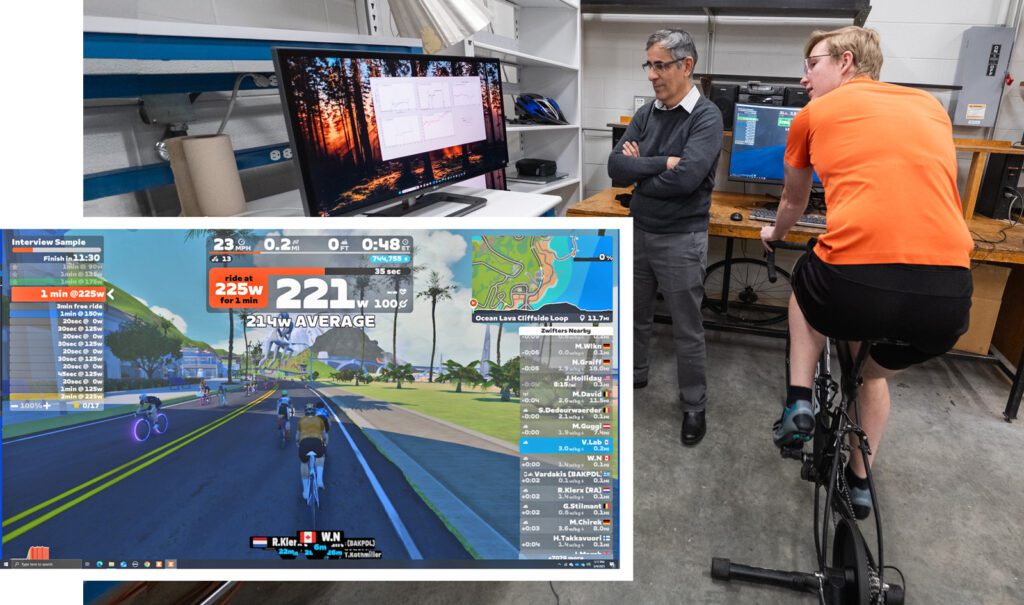Alex Minnich pedaled a stationary bike fast enough to break a sweat while a digital avatar on the screen in front of him raced down a two-lane road and five line graphs on a separate screen tracked his vitals.
It might sound like a scene out of a high-tech fitness center, but the setting was a Clemson University lab where the mechanical engineering major was demonstrating the research he is conducting with Ardalan Vahidi, a mechanical engineering professor.
The work—initially inspired by Vahidi’s research into hybrid cars—could ultimately help create personalized workout plans that help bicyclists make the most of their exercise time, said Minnich, Vahidi and others involved in the project.
“I’m really passionate about this,” Minnich said. “This research is a gift from God. It is absolutely perfect—combining my love of mechanical engineering and biomechanics with the knowledge I already have.”

The cycling research stands as an example of the many unique projects that Clemson faculty offer to keep undergraduates engaged and help prepare them for the rigors of what they do after graduation, whether it is graduate school or launching a career.
Part of what makes the cycling research particularly distinctive is that Minnich is leading a project as a junior and that it combines one of his hobbies with his ambitions as a mechanical engineer. It also highlights the creative ways Vahidi has used bicycles for years to teach engineering concepts.
Conducting research shows students how science can be put to use and sometimes encourages them to continue into graduate school and to inspire fellow students, Vahidi said.
“That’s always a big motivating component of my job—not only to teach in class, but get students involved in research and show them what research is like,” he said. “So then maybe they will go on to careers that involve research.”

Vahidi, a fellow of IEEE and ASME, is best known in his field for his work in control of connected, automated, and hybrid vehicles and applications of optimal control. He brought bicycles into the lab as far back as 2007, when a group of undergraduates outfitted a pedal-power Mongoose with an electric motor, cruise control and inclinometer.
Vahidi took the cycling work a step further a couple years later when it struck him that hybrid vehicles and bicyclists both produce power and both could use control techniques to plan how the power should be distributed over time.
Overall, for this research, we are trying to find what your max power and your max cadence are at a specific fatigue level. We know what power you should do, but we don’t know the optimal RPM you should do it at.
ALEX MINNICH, MECHANICAL ENGINEERING JUNIOR
While the goal for a hybrid car might be to minimize energy use, for a cyclist it could be to win a race, Vahidi said.
“How do I strategize? How do I pace myself?” he said. “The idea was, can we develop individualized models of a person using data from the lab that tells us how fast they get fatigued as they produce power and how they recover?”
Greg Mocko, an associate professor of mechanical engineering at Clemson, and Randy Hutchison, a professor of health sciences at Furman University, later joined the research. Their work led to several joint conference and journal publications.

Hutchison, who has a Ph.D. in bioengineering from Clemson, continues to collaborate with Vahidi on developing bioenergetic models of fatigue and recovery.
“We are machines in the sense that we combust food and oxygen in the same way an engine combusts gasoline,” he said. “However, it’s way more complicated with humans, and it’s nuanced.”
The Vahidi lab bicycle research has not only given students an opportunity to conduct research but has resulted in papers in IEEE Transactions on Control Systems Technology and Control Engineering Practice.
Minnich is now working with four test subjects for his project. When they visit the lab in Fluor Daniel Engineering Innovation Building, he has them pedal as hard as they can while he stands behind them and encourages them.
Non-invasive sensors measure heart rate, muscle oxygenation, total hemoglobin, pedal power and pedal RPMs.
“Overall, for this research, we are trying to find what your max power and your max cadence are at a specific fatigue level,” Minnich said. “So we’re trying to create that parabolic curve that correlates the power produced to your RPM at a specific fatigue level. We know what power you should do, but we don’t know the optimal RPM you should do it at.”
Among those helping dig even deeper into the research is Asal Lotfi, a master’s student in Vahidi’s lab. Data generated from Minnich’s work could help her figure out the best way for people to maximize their exercise time.
“Maybe in the future, we can tell them how to exercise so that, for example, they can have more calorie burn,” Lotfi said.
Minnich, a member of the Honors College and Clemson Cycling Club, and Vahidi are now considering writing a paper together. Meanwhile,Vahidi and Hutchison are pursuing funding to advance the research further.
Thus far, the work Minnich has done has had the side benefit of helping him better understand just how hard he should pedal when he hits the road on his bicycle.
“Making the most of the little time I do have to train and understanding my body better makes all the difference,” he said.
Get in touch and we will connect you with the author or another expert.
Or email us at news@clemson.edu

